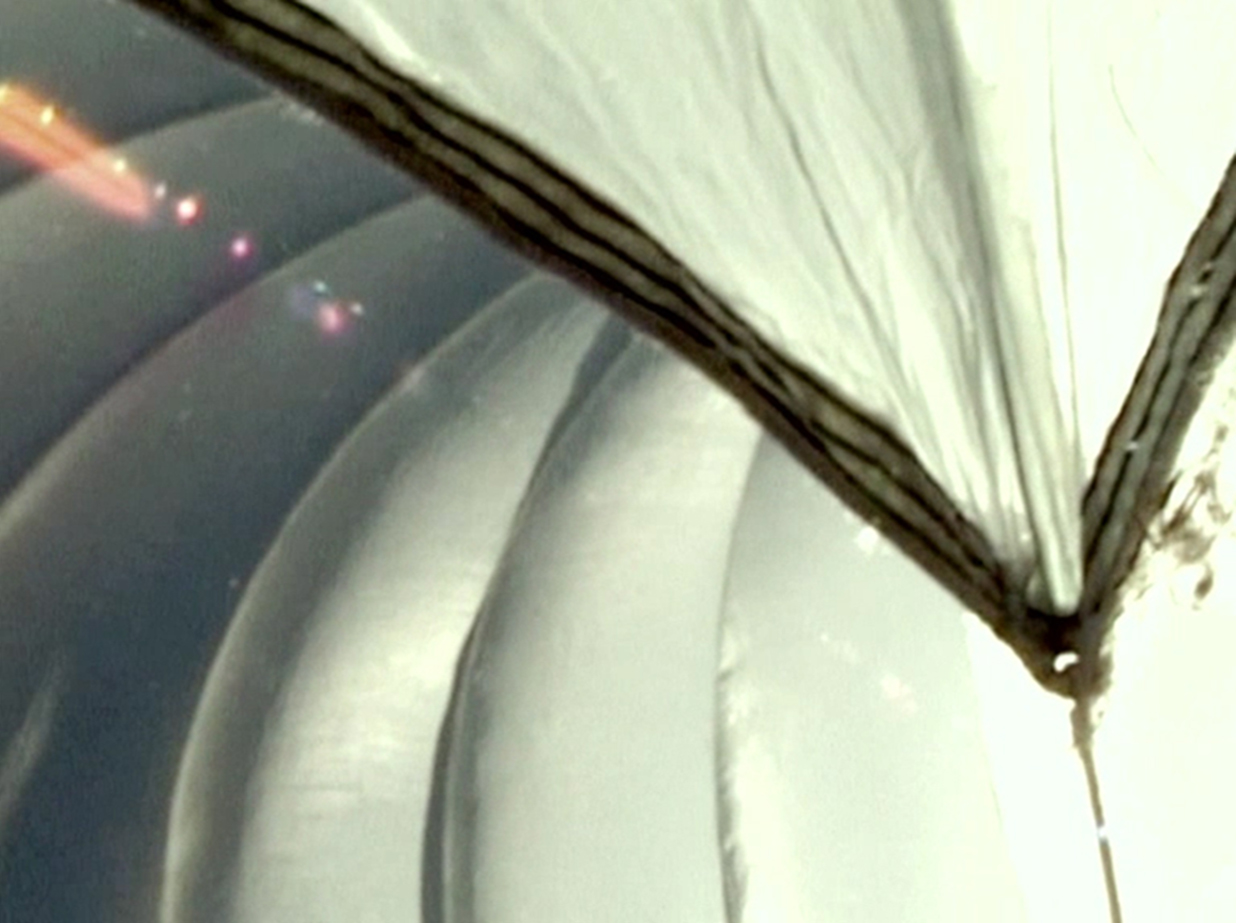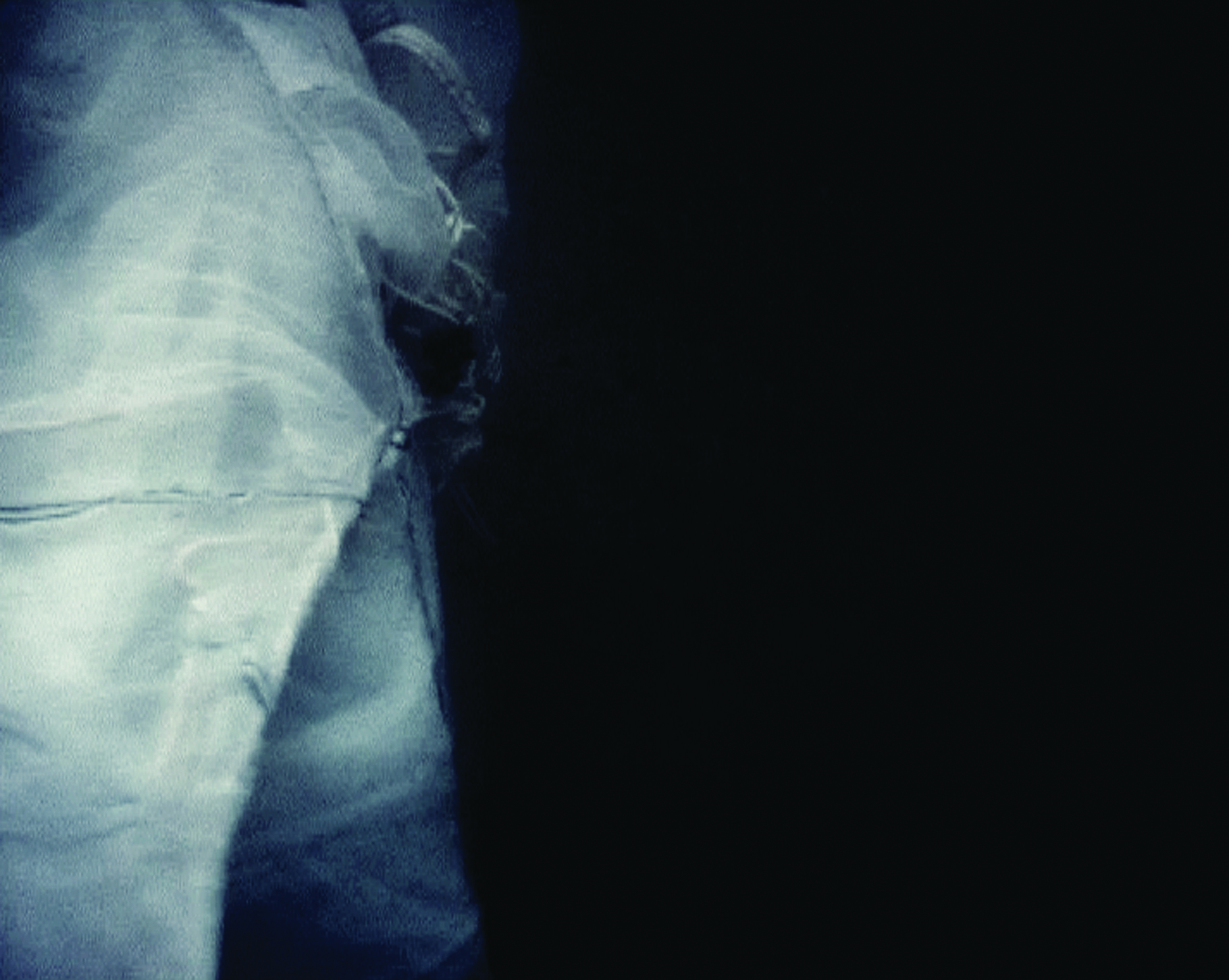






The Fall, 2004, single-channel Digital video, 4:3, stereo sound, 4 minutes 8 seconds
I looked into the sea with the same sense of trespass that I have felt on every dive.
Mel O’Callaghan’s first film, The Fall, moves ominously through a series of images: a billowing parachute, a close- up of a limp hand, the dark swell of the ocean, a figure’s expressionless face, a figure plunging into the ocean, a backlit silhouette, and finally the figure and parachute sinking to the ocean floor. There is no breath. Immersed
in the ocean, the figure is subjected to a strange interplay of gravity and buoyancy as it sinks under the weight
of the mushrooming parachute. There is a sense of estrangement; there is no evidence of a physical struggle, instead the figure appears calm and peaceful, as if they have slipped into the glow of a serene rapture. Over the course of the four minute film, a potentially sudden death is played out in slow motion. The imagery is allied with a piercing drone sound to create a sense of peaceful surrender as the parachute and figure recede into the void.
Visually, the film is restrained. However, within this dreamy, ambiguous narrative, the potential for unease
and distress is ever-present. It carries an uncanny air that is heavy and anxious, yet difficult to pinpoint. The unsettling atmosphere created by the work is heightened by the spatial and temporal disjunction of the images. O’Callaghan creates a kind of pictorial script that lays out gestures, sculptural forms and motion along with a discordant soundtrack that is part vocal and part instrumental. The effect is a contradictory mood with a subtly affective dissonance, simultaneously disturbing and compelling.
The figure is a lure. It provides a glimpse of narrative that allows the work to shift between evocations of physical, sculptural forms and interior psychological states. The water, like the absorbing blackness of the final imagery,
is an embracing medium that traps O’Callaghan’s figure in a languorous journey within the enveloping and consuming action of the parachute. For O’Callaghan, Jacques-Yves Cousteau’s personal reflections on the abstractions of deep sea diving and the strange joy it brings was a key reference point while making the work. Like Cousteau, O’Callaghan’s enduring focus on testing the thresholds of human experience is evident here in her first film. The Fall displays a fierce insistence on getting beyond the physical and going deeper beneath the surface to experiment with frequencies of emotion and consciousness. It is a desire to push through inertia.
And in O’Callaghan’s soft silvery film, the physical is ancillary; the pictorial illusion carries as much weight as the internal reality.
Michelle Newton
Film credits
Performer: Daniel Carlisle
Composer: Kim Moyes
Cinematographer: Benjamin Storrier
Editor: Mel O’Callaghan and Andrew van der Westhuyzen, Collider Films
Stunt coordinator: Brit Sooby
Producer: Clemens Habicht
MEL O’CALLAGHAN
The Fall 2004
Colour video with sound, 4 minutes 8 seconds (looped)
Courtesy of the artist; Galerie Allen, Paris; and Cassandra Bird, Sydney
O'Callaghan's first film, The Fall, sets the tone for the artist's enduring focus on locations present and haunted by water and the thresholds of human experience. The Fall is a sudden death played out via a slow-motion pictorial script: corporeal gestures, a sculptural billowing parachute, the dark swell of the ocean, a body plunging into the water, and, finally, a slow descent to the ocean floor. The film is set to an incongruous soundtrack that is part-vocal, part-instrumental and the fragmented narrative shifts attention between physical forms and interior psychological states. The Fall is the artist’s reflection of French oceanographer, filmmaker, and undersea explorer Jacques-Yves Cousteau’s ruminations on the visual fragmentation of deep-sea diving and the odd euphoria of submergence. The Fall displays O’Callaghan’s fierce insistence on going deeper, beneath the surface and beyond the physical, to experiment with frequencies of emotion and consciousness.
Film credits
Performer: Daniel Carlisle
Composer: Kim Moyes
Cinematographer: Benjamin Storrier
Editor: Mel O’Callaghan and Andrew van der Westhuyzen, Collider Films
Stunt coordinator: Brit Sooby
Producer: Clemens Habicht
MEL O’CALLAGHAN
The Fall 2004
Colour video with sound, 4 minutes 8 seconds (looped)
Courtesy of the artist; Galerie Allen, Paris; and Cassandra Bird, Sydney
O'Callaghan's first film, The Fall, sets the tone for the artist's enduring focus on locations present and haunted by water and the thresholds of human experience. The Fall is a sudden death played out via a slow-motion pictorial script: corporeal gestures, a sculptural billowing parachute, the dark swell of the ocean, a body plunging into the water, and, finally, a slow descent to the ocean floor. The film is set to an incongruous soundtrack that is part-vocal, part-instrumental and the fragmented narrative shifts attention between physical forms and interior psychological states. The Fall is the artist’s reflection of French oceanographer, filmmaker, and undersea explorer Jacques-Yves Cousteau’s ruminations on the visual fragmentation of deep-sea diving and the odd euphoria of submergence. The Fall displays O’Callaghan’s fierce insistence on going deeper, beneath the surface and beyond the physical, to experiment with frequencies of emotion and consciousness.
Film credits
Performer: Daniel Carlisle
Composer: Kim Moyes
Cinematographer: Benjamin Storrier
Editor: Mel O’Callaghan and Andrew van der Westhuyzen, Collider Films
Stunt coordinator: Brit Sooby
Producer: Clemens Habicht